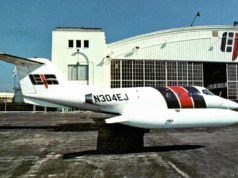In 1964, Sean Connery made his third appearance as James Bond in Ian Fleming’s Goldfinger. We watched Bond board Goldfinger’s Lockheed JetStar, at that time the largest and longest-range business jet available. Fifty two years and seven actors later, we’ve moved from Connery’s high voltage confrontation with Oddjob, to Daniel Craig’s Bond running a virtual parkour obstacle course in 2006’s remake of Casino Royale.
In those 52 years, business aviation has evolved as well, from piston to turboprops to jets – in the process more than doubling the airspeed and quadrupling the range. But bizav’s goal hasn’t changed. It’s still to make the most efficient and effective use of your time, whether that’s increasing face-to-face communications with clients and customers, visiting your distant plants and facilities, or overseeing your key investments.
Today’s communications no longer require extended air travel. Conference calls, emails, smart phone apps, and ’round-the-clock Internet connectivity replace many regular onsite regional and divisional meetings, as well as client and customer visits.
A recent Forbes study bears this out. Thirty-four percent of executives surveyed reported that their business travel was down dramatically since the 2008 recession, thanks in large measure to cost savings provided by the technologically-enabled lower cost alternatives.
But words, whether written or spoken, are only part of communications. It’s tough to read body language and other social cues in texts, emails, or phone calls – even on 53-inch flat screens or Skype. We may not be quite sure if the moment’s hesitation before answering is preparation for a thoughtful response, a technical glitch – or resistance to the message. In that same Forbes survey, 87% of executives echoed these concerns, preferring in-person connection to sterile Internet interaction.
As reliable as technology is today, we still value the human touch. It’s required to build trust and strong business relationships – and to close the deal. During the peak of the ’70s business jet boom, Learjet delivered that message loud and clear via a billboard that arriving commercial airline passengers saw as they headed into the city. It read:
That just about said it all when it came to business jet travel in those days – and it appears that you agree. According to Argus’ TRAQ Pak 2015 flight activity data, business jet and turboprop flying is up for the second straight year.
Back in 1964, the old Bell System advertised its direct-dial, long-distance telephone service with the catchy phrase, “It’s the next best thing to being together.”
Next best.
Being there is best.
That’s why you use business aircraft. BAA
Publisher of Business Aviation Advisor, has nearly 50 years in business aviation including executive positions at aircraft management/charter and ground services companies. He is a past director of the NATA and Corporate Angel Network.





